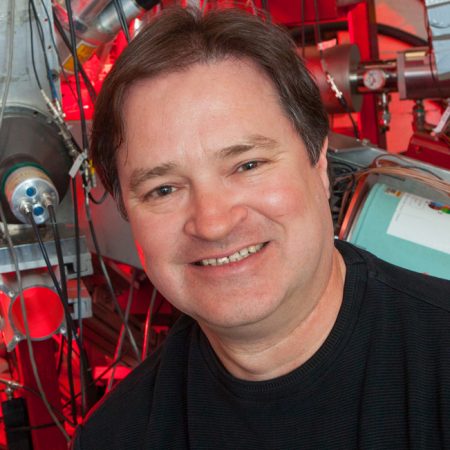
Mark A. Riley, a world-renowned nuclear physicist in the Florida State University College of Arts and Sciences, has been named the 2014-2015 Robert O. Lawton Distinguished Professor, the highest honor the university faculty bestows on one of its own.
Riley will be recognized during the university’s spring commencement ceremony at 7:30 p.m. Friday, May 2, at the Donald L. Tucker Civic Center, 505 W. Pensacola St.
“Dr. Riley’s research into nuclear-structure physics and the techniques of gamma-ray spectroscopy have given him international stature and make him an excellent choice for this high honor,” said Interim President Garnett S. Stokes.
“Mark Riley’s spectacular career makes him eminently worthy of joining our university’s top layer as a Lawton Professor,” said Sam Huckaba, dean of the college. “His contributions have been comprehensive, lasting and far-reaching. On behalf of the College of Arts and Sciences, I congratulate Mark, and thank him for his dedication.”
Riley, who joined the Florida State physics faculty as an assistant professor in 1991, was promoted to associate professor in 1994, full professor in 1996 and named the Raymond K. Sheline Professor of Physics in 2001. In addition, he served the university’s Department of Physics as associate chair from 2003 to 2007 and as chair from 2007 to 2013.
“Florida State is an amazingly vibrant community with faculty performing incredible work, so I am deeply honored and humbled to receive this award,” Riley said. “My own research is very much a team endeavor and I have been extremely fortunate to work with some brilliant collaborators and superb students throughout the years. It has been — and continues to be — a lot of fun, and I would not be where I am today without them.”
A giant in the field of low-energy nuclear structure, Riley has distinguished himself as a researcher who combines technical expertise to produce the highest quality experimental data with theoretical knowledge to extract meaning from the data to establish new information in the field of nuclear physics. In addition, he has proven himself to be a leader in the field of nuclear science through his service on the nation’s most important nuclear science advisory committees, and by the talks he is routinely invited to deliver at international meetings concerning his numerous research collaborations with leading scientists from the U.S., Britain, Sweden and Denmark.
As a result of his research, Riley was elected a fellow of the American Physical Society in 2000. The citation praised his “pioneering contributions to the exploration of atomic nuclei at high angular momentum values.”
Riley has written 146 articles published in refereed journals, 41 articles published in conference proceedings and delivered 91 invited individual talks. He has presented three series of invited lectures at international nuclear physics summer schools and has written an invited book chapter, “High Resolution Gamma-Ray Spectroscopy: The Gamma-Spheres,” in the Encyclopedia of Nuclear Physics and Its Applications,” published by Wiley-VCH in 2013. In addition, Riley has written two invited articles in the McGraw-Hill Yearbook of Science and Technology.
As a teacher, Riley’s effectiveness and popularity are driven by his charisma, infectious enthusiasm, challenging lectures and pioneering use of new technologies to aid classroom instruction, such as clickers. Florida State honored Riley with University Teaching Incentive Program (TIP) Awards in 1994 and 1997, University Teaching Awards in 1999 and 2007, and with a Distinguished Research Professor Award in 2007.
As a mentor, Riley has served as a major professor to three post-doctoral research associates, 13 doctoral students and three master’s students.
In a letter supporting Riley’s nomination for the Lawton Distinguished Professorship, U.S. Naval Academy Professor Daryl J. Hartley, who earned his doctorate under Riley’s supervision, praised Riley for the “great” and “positive” influence he had on his life.
“Now that I know almost all of the major research professors in the field of nuclear structure, if I could choose any professor at any school, I would not hesitate to choose Mark Riley as my adviser again,” Hartley said.
Riley holds two degrees from England’s University of Liverpool — a Bachelor of Science with Honors in physics, 1st Class, earned in 1981, and a doctorate in nuclear physics, earned in 1985. He worked as a research associate at the Niels Bohr Institute at the University of Copenhagen from 1985 to 1987 and as a research associate at the Oak Ridge National Laboratory and University of Tennessee from 1987 to 1988. Prior to joining the Florida State faculty, he served as an advanced fellow at the University of Liverpool.
The Lawton Distinguished Professor Award was first presented in 1957. The award was known as the Distinguished Professor Award until 1981 when it was re-named in honor of the late Vice President for Academic Affairs Robert O. Lawton. At that time past recipients also were designated Lawton Distinguished Professors. To view a list of all Robert O. Lawton Distinguished Professors, visit https://provost.fsu.edu/faculty/awards/distinguished-professor/.




